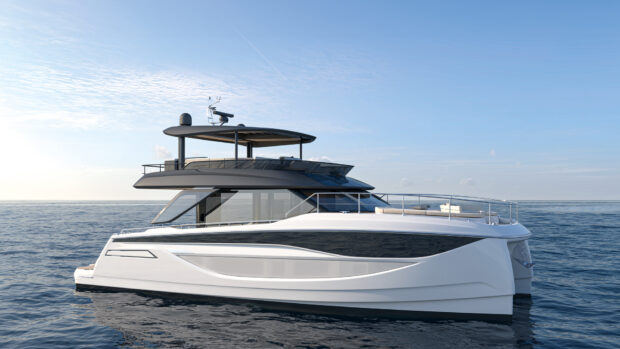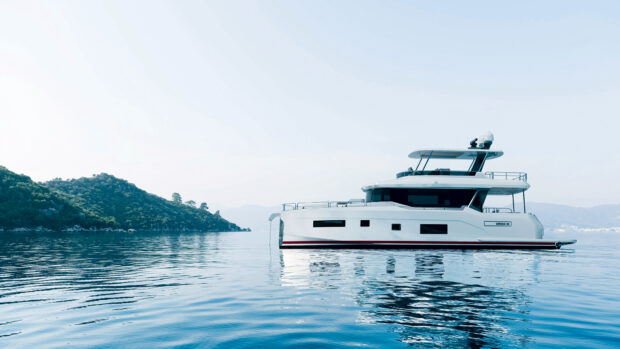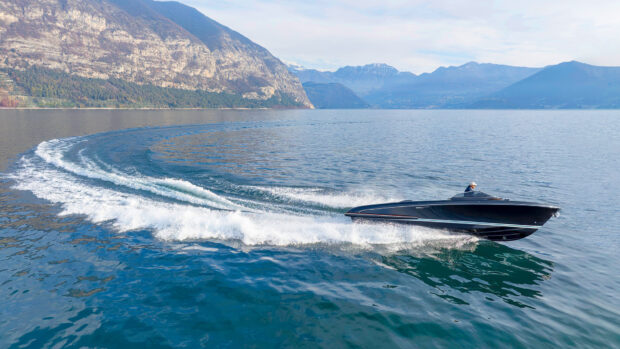After braving the Gulf de Penas Scott and Mary had some ups and downs before reaching their anchorage
Position: Caleta Suarez, Estero Como, Taitao Peninsula , Chile
Scott (YT) and Mary Flanders left Gibraltar on 16 September 2006, and we’ll be following their journey every step of the way, thanks to this unique online “blog”. For a complete list of all the couple’s blog entries click here
After braving the Gulf de Penas Scott and Mary had some ups and downs before reaching their anchorage
Saturday 5 January
Egret is under way crossing the Gulf de Penas. In 31.34nm we will reach the headland off Point Rapier and then we will turn along the peninsula for tonight’s anchorage.
We agonized about leaving or moving to a close-by caleta until the weather became more settled (we have another front due in 24 hours) or giving the crossing a go with the option to retreat after 10 miles or so. There was little wind last night. The alarm went off at 0315, by 0400 the chain was dropping into its locker and at 0427 we cleared out of Caleta Ideal using radar and entered the fairway between two islands. The bottom line at this time is there is a two-metre swell from the northwest mixed with a three-metre swell from the west-southwest. There is little wind and no wind chop on top.
The ride is quite comfortable at 1675rpm and an average speed of 6.5 knots, although this speed will drop a bit as we approach the cape and its southbound 1-knot current.
When we entered the gulf there was just a bit of opaque light illuminating the silver grey water. Dark heads popped up to the surface with wide-eyed looks from time to time (sea lions) and further offshore albatrosses were working the waves. One in particular is the largest we have seen to date.
During Egret’s first long distance offshore adventure, from Fort Lauderdale to Nantucket, we saw our first shearwaters working the slight pressures, positive and negative, caused by the waves and the wind. Both MS and I watched them for hours during our watches. Albatrosses soar much the same but are a larger, heavier bird with more presence as with shearwaters; we have watched them for hours since being in the Deep South.
OMNI Bob, the grib files and the Chilean weather report this morning from Faro San Pedro all suggest there will be increasing winds from the northwest this afternoon. The seas are expected to increase accordingly, probably a by a metre or so. By that time we should have turned the corner so we’ll give the Naiad Multi Sea II knobs a twist and let them do their best in the beam seas – at the moment they are turned down a bit. We try to run as little fin as possible to keep our speed up. Egret is very comfortable and it shouldn’t matter if she rolls a little.
Sunday 6 January
Yesterday’s trek to the anchorage included a number of variables, as many near shore trips do. Firstly we had no wind and mixed swells, our next diversion was the meeting of the 200m shelf Egret was crossing and the 400m drop off. Upwellings are caused when you have a sharp delineation in depth along with current and these can lead to confused seas in exactly the same wind conditions. It was along this demarcation that we saw for the first time wandering albatrosses. During our entire stay in the Deep South we have never seen a wandering albatross – black browed albatrosses by the hundreds but never the granddaddy of them all. What a thrill. They would soar by the boat, work the wake for whatever it might bring, then peel off to a dot in the distance only to reappear shortly after. We saw what appeared to be quite a number of wanderers that stayed with us for hours, but then again it may have been a relative few putting in the miles.
I could go on forever about feelings at times like these but I won’t. You must understand we lead simple lives without media distractions and the intricacies of dirt-dwelling life. Such simple pleasures as seeing a soaring bird gives us unimaginable pleasure and the longer we are away from distractions the more we change. We have thinned our shell of toughness and have become more fragile. To preserve this fragility we avoid the media in its different forms as much as possible and wander in opaque ignorance. This is perhaps unusual by contemporary western society standards but this is how we live and it works for us.
As we neared Cabo (Cape) Rapier the winds increased as expected. Just as water likes to follow a surface so does wind. A disruptive projection into any wind or water flow causes the wind or water to be compressed and accelerated, wrapping itself around the projection. In this case, the large land mass projection of Cape Rapier took the five knots of wind we were enjoying, along with a late afternoon dropping barometer, which brought more wind, and pumped it to 20 knots. It’s easy to see how Cape Rapier, Cape Horn and all the capes of the world cause such distressing, violent weather when they are hit by a passing depression. The 20 knots of northwesterly wind diminished the northwest swell turning into shorter, tighter waves and created a lot of spray while lessening the pitch. The west-south-west swell increased to 3-4 metres, which looked like low lying islands in the distance when even higher sets popped up occasionally. This swell passed harmlessly under Egret before creating spectacular shoreside wave bursts.
In due time with fairy tale electronic charting, poor resolution (large scale) paper charting and our trusted Italian guide (Patagonia & Tierra del Fuego Nautical Guide) we turned to our anchorage and cautiously closed to shore. We had been running 5-6 miles offshore using the radar outline to match the paper charts and staying well away from the coast for a number of reasons, not least because of an east (lee shore) setting 1/2 knot current. In very heavy mist with about 1/4 mile visibility things were tense. Closing with shore we kept reducing the radar range down to 1 1/2 miles then 3/4 mile along with zooming up to see further ahead along the outline of the coast. It was terrifying when all we could see through the mist were waves exploding into the air. No visible shore, just white water flung skyward.
One defining landmark to our anchorage entrance was an island, which blocked the opening and had passages on either side. Finally, we found it and we slowly crept in past a dividing island while straining to see through the mist with binoculars. The radar was gave a false return because of a low-lying scrub valley, which made it look like the fjord. As the water became shallower than the guide indicated we realised we were wrong. Cautiously we backed out, moved further down the coast until the entrance island appeared hazily through the mist.
Without the books that have accompanied us on our adventure we would not be here. You can’t imagine sitting at home how difficult it is to find a safe haven in the impenetrable mist. Though we have experienced relatively mild weather it is horrific by our earlier standards.
Caleta (Cove) Suarez, Estero (Bay – Fjord) Como, is a three-mile deep gash into the peninsula running northwest to southeast. Near the end is a narrow peninsula protecting a tiny cove back to the north. According to our guide “this is one of the safest and beautiful coves in Patagonia”. We have to agree. Here we reached a second milestone for the day. Since passing Cape Rapier we have, in my mind, left the Deep South (with associated emotions). We are now at 46 degrees south putting us well into the Roaring 40s and into the Pacific Ocean, Egret’s first venture into the Pacific and third milestone of the day.
In this short hop from the wind-blasted, rain-scrubbed island and mainland mountains to the south, we have travelled to a different, temperate forest full of trees and plants we have never seen. A magical line like we have never seen in our travels, divides the two, as definitive as ocean and shore. Slowly motoring into the fjord we saw colourful ferns in many shapes and sizes including bright green displays. There are many varieties of trees compared with the four species of beech in the Deep South. The beaches aren’t hard rock but small pebble, deep sloping beaches that appear and disappear with the tide. On the way in we saw an occasional fur seal, pinguinos (penguins), rock shags (cormorants), albatrosses and other sea birds including two small petrels, giant petrels and two types of terns. As we neared the peninsula, which protects the anchorage, a whole family of fur seals popped their heads up.
Directly opposite Egret’s anchorage is a growth of red-leafed ferns unfamiliar to us. Merely feet away is a rope swing hanging from a tree made from a ubiquitous fisherman’s line which supports a rough sawed plank erected either by fishermen or cruisers. As remote and dangerous as this place is, I suspect it was cruisers passing time waiting for weather to cross the Gulf de Penas or resting after crossing just like us. We plan to hike along the continuous pebble shoreline and take it easy for a bit. Another front has arrived but we’re in no rush. In another life my fishing buddies and I used to have a saying; “You don’t leave fish to find fish”. Life is good for the Egret crew.
Monday 7 January
Thinking back over our mistaken entry into a smallish cove that couldn’t possibly have been the correct one I would just like to underline that under normal conditions with reasonable visibility this would not have happened. Unfortunately the mist was very heavy and in situations like this accidents do happen but by being cautious, slowly bumping in and out of gear, we escaped harm.
Our Italian guide has a line drawing of the entry island and fjord together with a scale, it is a rough guideline but adequate. If we had taken the time to use the compass and scale the island at the entrance we would have seen it was over 1/2 mile long, not the smaller island we saw at first. Basic seamanship. Our mistake. It won’t happen again, we escaped with a cheap lesson learned without penalty and we hope you’ve learnt from it too.











